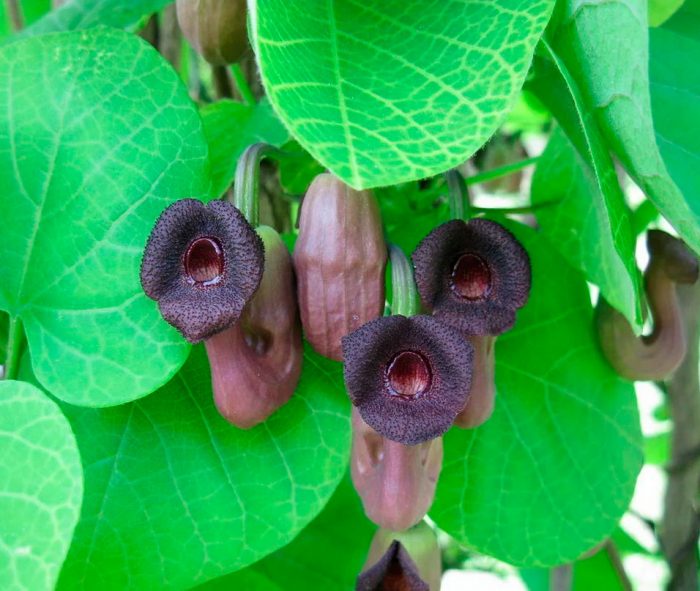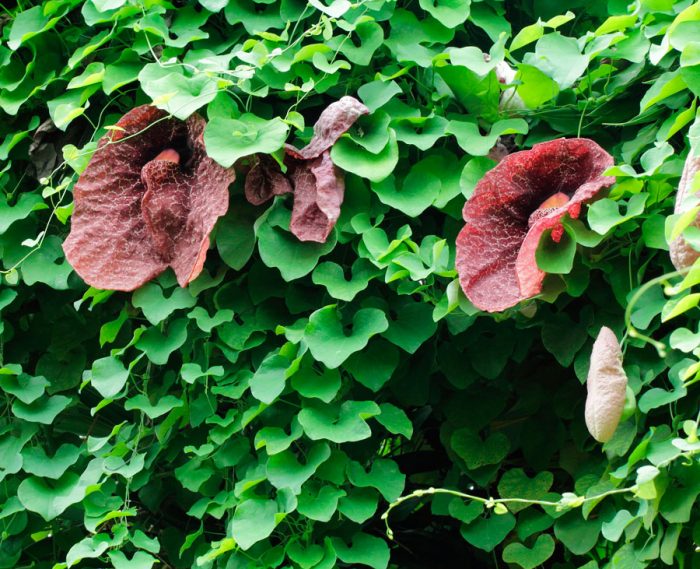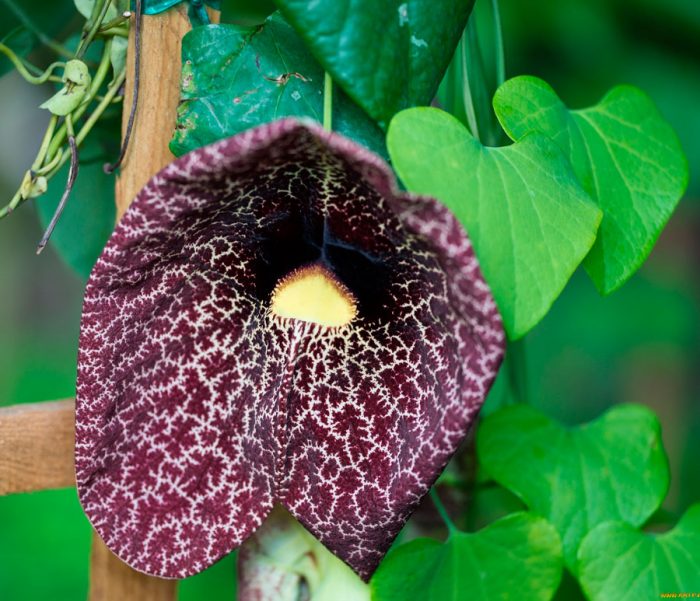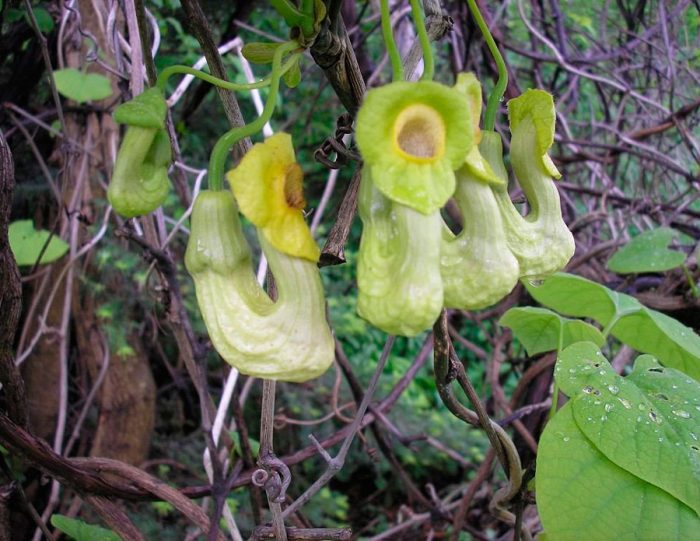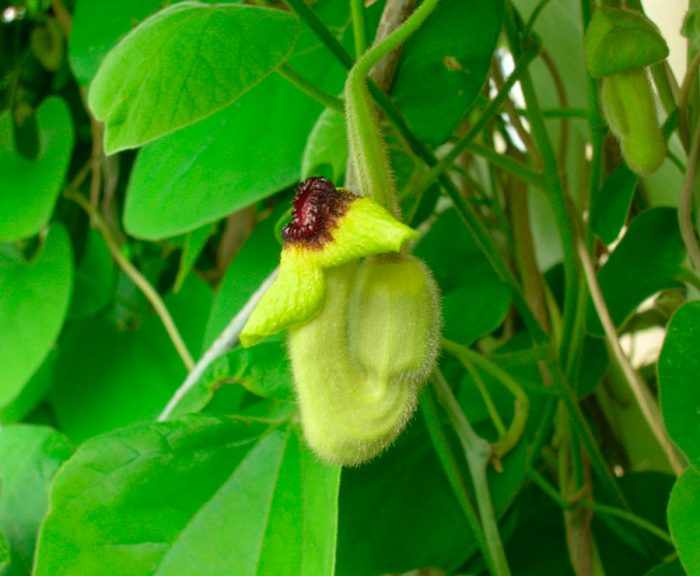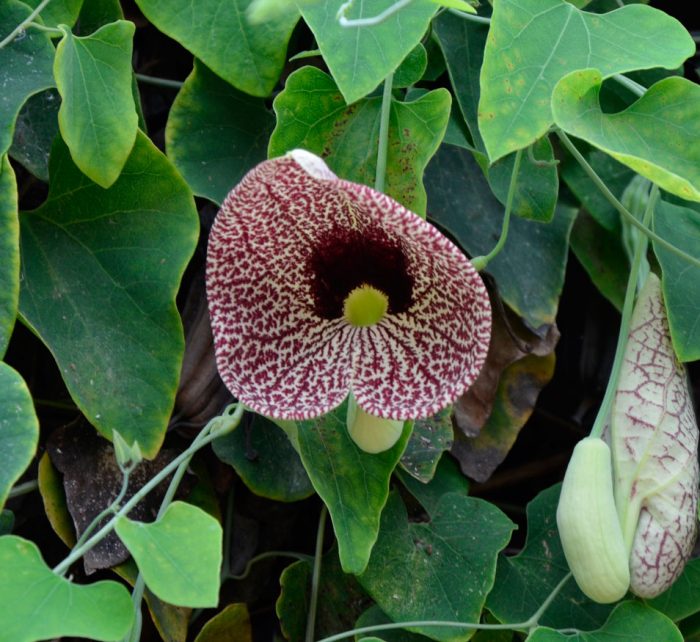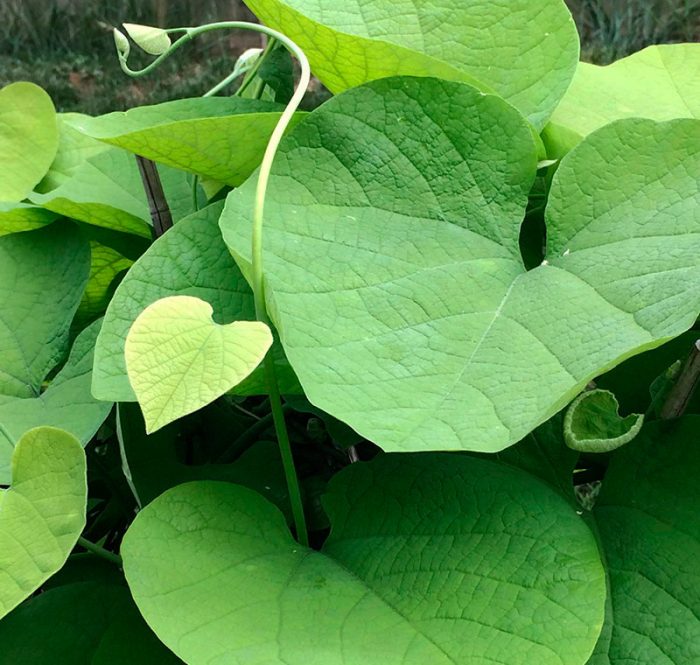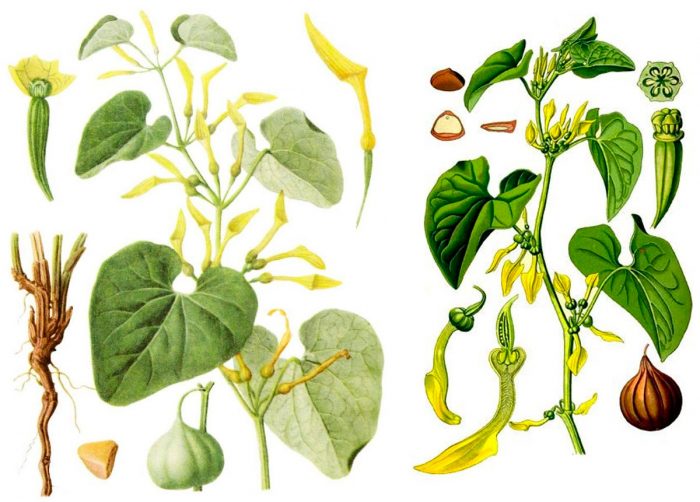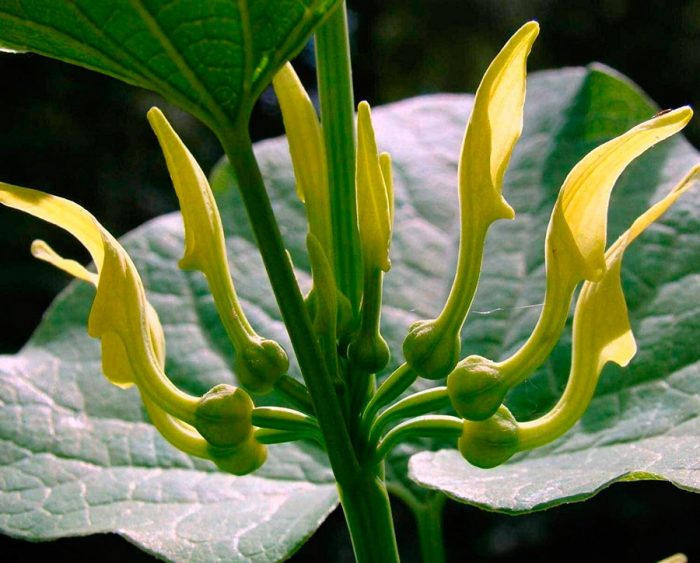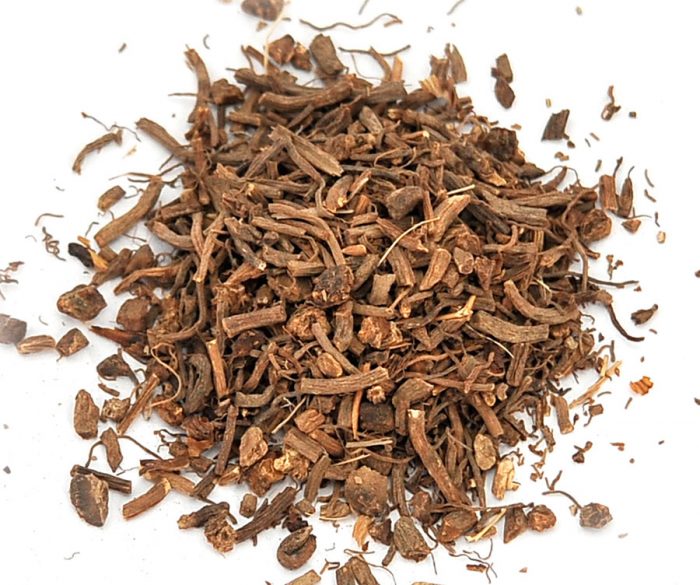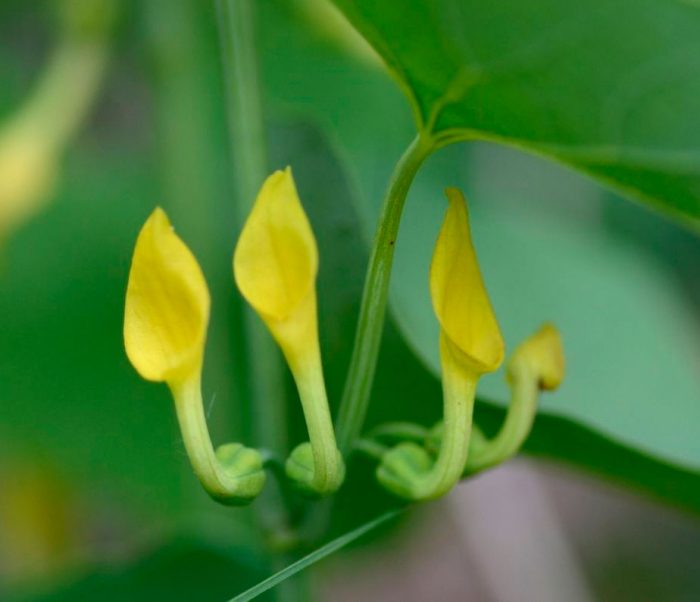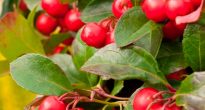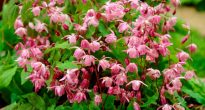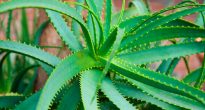The fast-growing liana-like plant Kirkazon, which is distinguished by its spectacular large leaf plates, is quite popular among gardeners. It is often used to decorate arches, gazebos or personal plots. This spectacular plant differs from other vines by its exotic flowers, which have an extremely unusual shape. The people also call kirkazon (aristolochia): serpentine, khvilovnik, evil grass, finnik, feverish grass, chubby, kokornik, royal beard.
A large number of Kirkazon species are quite widespread in garden culture. For example, you can often find such species as clematis, tubular, Manchurian and many others. In addition, Kirkazone is a medicinal plant that is quite actively used in folk medicine.
Content
Features of Kirkazon
The Kirkazon plant is part of the Kirkazonovye family, and this genus includes about 180 species. In nature, such a plant can be found in the tropical and temperate zones of Asia, America and Africa. In Russia, only 5 species of kirkazon grow in nature, which are found on the territory of the European part, in the North Caucasus and the Far East.
This deciduous perennial is a large creeping vine that has smooth, woody stems. They can be curly or upright. The average length of the shoots of such a plant is about 10 meters. However, there are species in which the stems are much longer, for example: in Kirkazon clematis they can reach a length of about 15 meters, and in Manchurian ones - about 20 meters. A wide crown and lush foliage are characteristic features of this plant. In addition, it is distinguished by very rapid growth; in the warm season, within 24 hours, its stems increase in length by 12-15 centimeters.
Wide large bright green leaf plates have a smooth edge and a heart-shaped or rounded shape. Such a plant differs from other vines in the same way in the arrangement of leaf plates.They are placed on top of each other, as a result of which they form a wide crown, which is outwardly similar to a tiled roof.
As mentioned above, Kirkazon flowers are not quite ordinary. They grow out of the leaf sinuses and are completely devoid of a corolla. The flower contains only the perianth, which looks like a jug, curved tube, horseshoe or gramophone. Most often, the upper part of the perianth is somewhat narrower than the lower, and there is a bend on it that looks like a tongue.
The first time the bushes bloom only after they are 5–8 years old. Kirkazon blooms from 5 to 25 days, and most often its flowers are hidden from the eyes by lush greenery. In place of flowers, fruits are formed, which are a box in the form of a ball or cylinder, in which the seeds are located.
Kirkazon grows best in little shade or shade, while the site must be well protected from drafts. In nature, on the territory of the Russian Federation, this liana-like plant is most often found in the southern regions. It is distinguished by its unpretentiousness and ability to grow even on solid ground.
Reproduction methods
Kirkazon can be propagated by cuttings, seed and root cuttings.
Propagation by cuttings
Cuttings are harvested in autumn and spring. For this, annual stems with several buds are cut, the length of the segments should be about 20 centimeters. The soil should be mixed with sand and humus. The segments are planted in the substrate at an angle, while several buds should rise above the surface of the soil mixture. Don't forget to feed the cuttings and water them well. After that, the cuttings are covered with glass jars, cut off plastic bottles or other transparent cap.
Reproduction by layering
It is much easier to propagate Kirkazon by layering than by cuttings. Pick a sturdy, healthy stem and lay it flat on the ground. Fix it in this position, and after 1 season it will give roots. The resulting cut will only need to be separated from the mother bush and planted in a permanent place.
Landing in open ground
The time of planting Kirkazon in open ground depends on how resistant the species is to frost. In this case, the planting of lianas is carried out in autumn or spring. Winter-hardy species are planted in the autumn, using two or three year old seedlings for this. Spring is suitable for planting species that are less resistant to frost. Since the root system of the bushes is shallow and wide, then when planting in open ground, a distance of at least 100 cm is observed between them.
The width and depth of the planting pit should be about 50 cm. At its bottom, a good drainage layer with a thickness of 10 to 20 centimeters must be made, for this you can use crushed stone, fragments of bricks, expanded clay or gravel. Drainage from above is covered with a layer of sand 5 to 10 cm thick, and organic matter is also introduced. The soil should be mixed with sand, humus and clay. Immediately, the support is installed, the length of which should not exceed eight meters. The liana will climb along it counterclockwise. Before proceeding with planting a seedling, its root system is shortened by 1/3. During planting, make sure that the root collar of the plant is flush with the soil surface.
If you need to transplant an adult bush to another place, then this procedure should be carried out at the beginning of the spring, before the foliage begins to actively grow.
Kirkazon care
In order for Kirkazon to grow and develop normally, it needs proper care:
- Water the vine systematically, without letting the soil dry out. During dry periods, remember to moisten the leaves with a spray bottle from time to time.
- It is enough to carry out 2 dressings during the season, using a mullein solution in a ratio of 1:10.
- You need to loosen the soil very carefully and not very deeply.The fact is that the root system of such a plant is superficial.
- Weeds should be removed from the site as needed.
- The surface of the soil around the stem and the entire root system should be covered with half-rotted loose leaves. Mulch helps to protect the soil from drying out, and during overheating it saturates the soil with nutrients.
- In order to preserve the decorative effect of the bushes, do not forget to cut out the dried foliage and stems in time.
Diseases and pests
Kirkazon is distinguished by a fairly high resistance to diseases and pests. But if a plant affected by a spider mite or aphid grows next to the liana, then the pests can move to it.
If a spider mite appears on the foliage, then it should be sprayed with a decoction of creeping bitterness. Pour in one liter of water from 100 to 120 grams of finely chopped dried herbs. Bring the mixture to a boil and simmer over low heat for 20 to 30 minutes. Remove the broth from the stove, wrap it up and leave to infuse for 15-25 minutes. Strain the broth and dilute with clean water in a 1: 1 ratio. Spray all leaves with a solution.
Wintering
Only an adult Kirkazon, who is 2 or 3 years old, is highly resistant to frost. Before the onset of the first autumn frosts, the shoots of a young plant should be placed on the surface of the site and covered with loose leaves, and the layer thickness should be from 8 to 10 cm.During winter, the tops of the stems may freeze slightly, but with the onset of spring, the plant quickly recovers.
Kirkazon graceful in winter in the open field will die. In this regard, in the fall, it should be landed in a container, which is placed in a heated, well-lit room. In order not to dig out the bush every year, it is simply not planted in the ground, but taken out into the garden in a container.
Types of Kirkazon with a photo
Most gardeners compare Kirkazon with weeds. It grows quickly, is able to easily take root on any soil and quickly climb a support. The flowers of such a plant look extremely unusual due to their bizarre shape. For example, in Salvadoran Kirkazon, the flowers are outwardly similar to a skull with large empty eye sockets. This species is often referred to as the devil's flower. And the Manchurian Kirkazon grows on the territory of Russia in the middle latitudes and is highly resistant to frost.
Kirkazon Manchurian (Aristolochia manshuriensis)
The trunk of such a vine is lignified. In an adult plant, the stems can be about 15 meters long and 6 to 8 centimeters across. The shoots are covered with soft cork bark. During the first three years of life, the shoots of this species do not grow very quickly. The plant needs support.
Large cordate-rounded leaf plates in length reach from 25 to 30 centimeters, there is a slight sharpening at the top. The foliage has a specific camphor aroma. In a young leaf blade, the lower part is covered with characteristic pubescence, and the upper part is much less pubescent. As the foliage matures, both of its surfaces are covered with short and sparse pubescence.
The small brown flowers are shaped like small jugs. The peak of flowering occurs in the last spring days. When the plant has faded, fruits are formed on it, the shape of which is similar to a cucumber. The dark-colored seed pods have an elongated shape (about 30 mm wide and up to 100 mm long), dark bare concave-convex seeds ripen inside them, reaching about 0.7 cm in diameter.One fruit contains from 50 to 130 seeds which ripen in mid-October.
Kirkazon Manchurian grows best on moist fertile soil, while the site should be in slight shade and have reliable protection from drafts. In just 1 year of growth, the stems can reach a length of about 300 cm. For reproduction, cuttings or freshly harvested seeds are used (sowing is carried out immediately after they are completely ripe).It is recommended to cover such a plant for the winter, especially if it is young.
Felt Kirkazon, or fluffy (Aristolochia tomentosa)
Outwardly, this species looks more like a highly branching shrub. Grows best in areas that are shaded and protected from gusts of wind. The bush can reach a height of about ten meters.
The petioles of the leaf blades are long and can reach from 50 to 70 mm. Ovate-rounded wide foliage has a diameter of 12 to 15 cm, its edge is smooth, rounded. The seamy surface of the leaves, shoots and petioles are covered with pubescence. At the same time, there is a rare pile on the front side of the leaves.
Single greenish, fleecy flowers grow at the base of the leaf plate and are more like a curved tube, which reaches about 35 mm in diameter. The flower is located on a long (about 50 mm) pedicel and has a three-lobed wrinkled limb of yellow color.
A moist soil rich in nutrients is suitable for this species. Unlike other species, this plant has a large number of young root shoots. The fruit is an elongated hexagonal capsule that can be 60 to 80 mm long.
Kirkazon graceful (Aristolochia elegans)
This evergreen vine is native to the tropics of South America. Heart-shaped leaf plates are rather large. During flowering, the bush is decorated with flowers that look like small gramophone pipes. Their width varies from 8 to 10 centimeters, and in length they can reach about 12 centimeters. The flowers are white, and they are decorated with dark brown and dark red spots. The bush blooms in July and fades in September. Pollination occurs with the help of flies and other insects. The closure of the entrance to the flower occurs after it is pollinated.
This species is distinguished by its thermophilicity, while it is recommended to choose a well-lit area for planting it. The plant can suffer from severe frost and drafts. In the fall, the bush is removed from the soil, planted in a container and brought into a warm room. In the spring he is returned to his place.
Kirkazon graceful should be regularly watered abundantly, as well as systematically fed with organic matter. For propagation, cuttings are used, which quickly give roots. Since the seeds do not have time to ripen well, they have low germination. And the emerging seedlings are characterized by extremely slow growth.
Kirkazon ordinary, or clematitis (Aristolochia clematitis)
This herbaceous vine is a perennial. In an adult bush, shoots can reach about 15 meters in length. Moreover, the length of young stems can be up to one and a half meters. The bare, upright, slightly curly stem is colored greenish. The rhizome in this species is creeping. It is recommended to choose a shaded area for growing it.
Rounded heart-shaped alternately matte leaf plates reach about 10 centimeters in length. They are colored green and have a rough edge. They give off a subtle unpleasant odor that is necessary to attract flies for pollination.
Flowering is observed from May to June and lasts about 30 days. At this time, the bush is decorated with yellow flowers, the shape of which is similar to a jug. One or several flowers grow from the base of the leaf plate. Only bushes over 5 years old bloom.
This plant is distinguished by its frost and drought resistance. At the same time, excessively abundant watering can harm him. For reproduction, segments of rhizomes are used, since seed setting is extremely rare and at the same time they do not have enough time to ripen well.
Kirkazon large-leaved or tubular (Aristolochia macrophylla)
The length of the stems of such a shrub vine can vary from 10 to 12 meters. Heart-shaped large leaf plates in diameter reach from 25 to 30 centimeters. They are attached to the shoots with petioles, reaching from 50 to 70 mm in length.
The bush blooms for 5-25 days. At this time, it is decorated with yellowish-green single flowers, which are shaped like a curving tube. They have a brown three-lobed limb, the length of which is no more than 30 mm.
For pollination, the flowers of such a plant need flies. A pollinated flower closes the entrance to it. The bush begins to bloom only after it is at least 5 years old. In a faded bush, fruits are formed on a long stem, in the form of a hexagonal cylinder. Seeds ripen inside them.
To make the bushes grow better, they are planted in a nutritious soil, while choosing a shaded place that has good protection from strong gusts of wind and drafts. The fact is that the wind can injure foliage. Water them regularly, preventing the soil from drying out. The species can be propagated by layering and by seed. In this case, the seed material quickly loses its germination capacity.
Healing properties
Kirkazon clematis contains poisonous substances. Because of this, drugs made on its basis can only be used as directed by the attending doctor and under his supervision. It is the doctor who should prescribe the dosage. For many centuries, the medicinal properties of other types of kirkazone have been studied. The description and methods of using such a plant can be found in various works and manuscripts.
This vine has the following beneficial properties: antimicrobial, wound healing, antiviral and antifungal. It is used to strengthen immunity and to normalize metabolism.
Kirkazon clematis is used in official medicine for the treatment of various diseases, namely:
- respiratory diseases - cough, flu, pulmonary tuberculosis, shortness of breath, tonsillitis and SARS;
- violations in the female reproductive system - cystitis, problems with the menstrual cycle, erosion, infertility and fibroids;
- skin diseases - scabies, psoriasis, dermatosis, edema, rashes, abrasions, bedsores, itching, festering wounds, varicose ulcers, eczema and diaper rash;
- diseases of the vascular and cardiac system - varicose veins and hypertension;
- problems in the activity of the nervous system - migraine, nervous exhaustion and overwork, headache, insomnia, neurasthenia and stuttering.
In alternative medicine, based on such a plant, tinctures, decoctions and ointments are prepared for external use.
People have known for a long time that Kirkazon has healing properties. In Eastern and Chinese traditional medicine, this plant is used for a variety of diseases. And African peoples use it as an antidote for snake bites.
Contraindications
The plant contains poison, and therefore funds based on it cannot be taken over the norm. It cannot be used by pregnant women, breastfeeding women, and even children. It is also contraindicated in uterine bleeding, gastritis, individual intolerance, and also in diseases of the kidneys and liver.
When applying compresses or when rubbing the skin, a burn may form (if the skin is highly sensitive) or a burning sensation (in the case of fungal skin lesions) may appear. Most often they are used only externally.
Decoction of roots
A decoction is obtained from the roots of Kirkazon, which is used for compresses and added to the bath. It helps with the following ailments: joint and skin diseases, as well as metabolic disorders.
Pour half a liter of freshly boiled water into a thermos and add 2 or 3 tablespoons of finely chopped dried roots. Close the thermos with a lid and leave for 2-3 hours, then pour its contents into a saucepan and simmer for 5 to 7 minutes. Remove it from the stove and cover with a towel for half an hour. The cooled broth is filtered. It is used to wipe problem areas (for 15-25 minutes), to prepare foot baths or to make compresses (put overnight).
Tincture
A tincture is prepared from the herb of such a plant, which is used for lotions with severe pain or inflammation on the skin. Half a glass (100 ml) vodka and ½ tsp. Finely chopped dried Kirkazon herb is mixed and poured into a container, which is tightly sealed and placed in a cool dark place for 7 days. Do not forget to shake the contents of the container once every couple of days. They drink three times a day, while using from 15 to 20 drops.
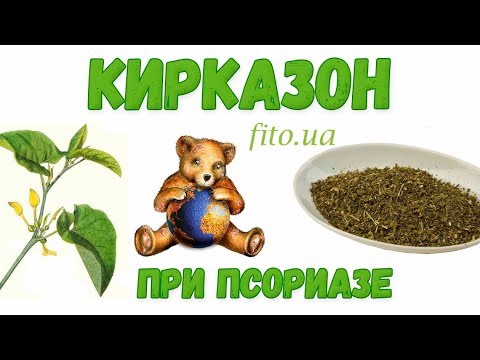

Watch this video on YouTube
Procurement of raw materials
Both the roots and the herb kirkazon have healing properties. The foliage and shoots are trimmed during peak flowering, and the roots are removed from the ground in the fall. The above-ground part of the bush is laid out on a horizontal plane in a well-ventilated room; it must be turned over systematically. Avoid direct sunlight. Remnants of soil are removed from the roots with cool water and dried in an oven at 60 degrees.
The finished raw materials are stored in a tightly closed container for about 2 years.
Pharmacological properties of Kirkazon clematis
Aristolochinic acids contained in Kirkazone clematis increase heart contractions, cleanse the body of excess fluid, and promote vasodilation. Funds based on such a vine are very effective in viral and fungal diseases.
It also contains capillary poison, which tends to accumulate in tissue cells. It is used very carefully, because the carcinogenic effect can appear after a long period of time.
The chemical composition of different types of Kirkazone can differ significantly, but they also have common components - these are aristolochic acids and their compounds (glycosides, lactones and esters). The greatest danger is precisely the lomonosoid Kirkazon, because it contains the highest concentration of aristolochic acids I and II.
The plant also contains essential oil, phenolic acids, bitter and tannins.
Kirkazon in landscape design
The fast-growing Kirkazon plant with lush greenery is used for vertical landscaping of building facades, fences, balconies, gazebos and terraces. And also to create green verandas and tunnels, and a green background for flower beds.
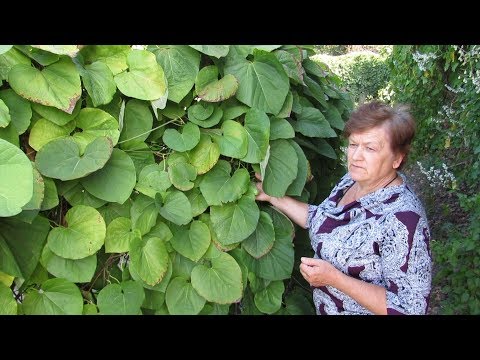

Watch this video on YouTube

